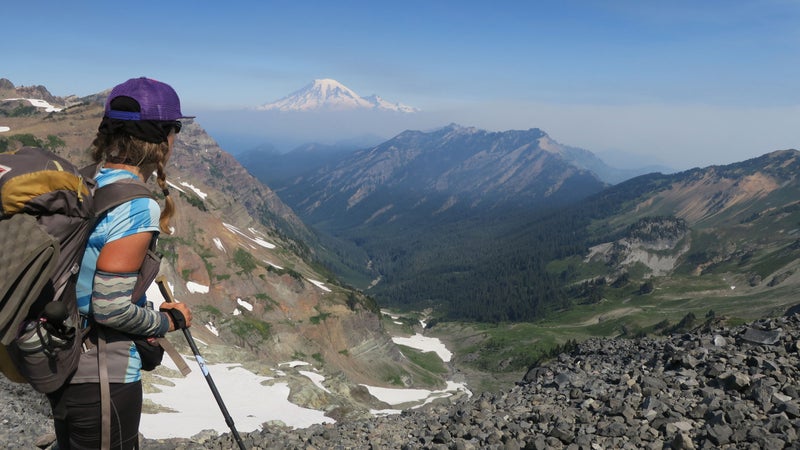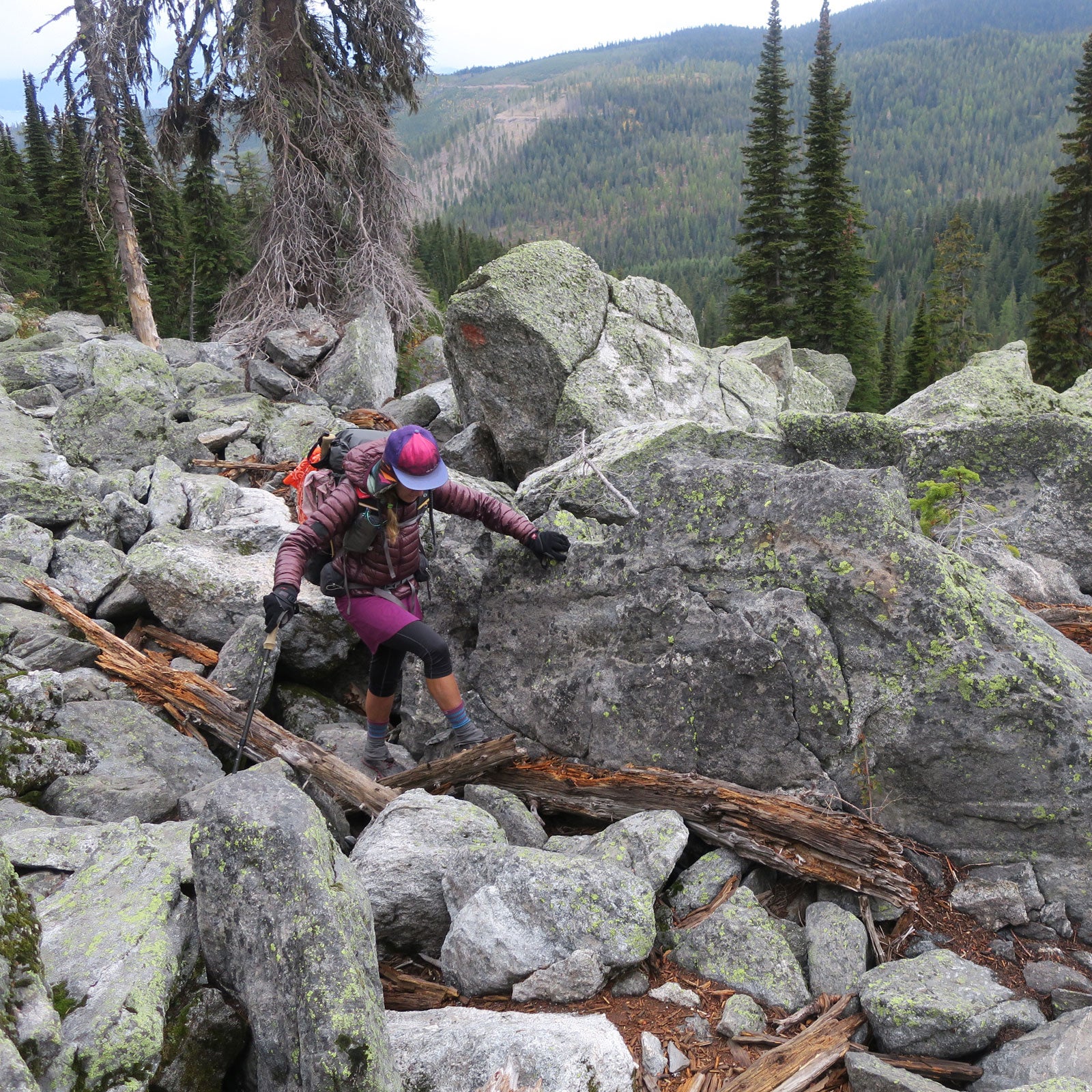What if you could spend a full season hiking to more than a dozen hot springs, photographing petroglyphs, and camping in the most remote wilderness in the lower 48? Well,╠řyou can do all that and more, thanks to a new thru-hike╠řcreated by╠řRas and Kathy Vaughan.╠ř
Full-time adventurers, the Vaughans, married for 22 years, have made a habit of setting only known times╠řwhere they establish never-before-recorded routes. They call themselves Team ,╠řand they named their new╠řtrail the UltraPedestrian╠ř(or UP)╠řNorth Loop.╠řThe thru-hike combines parts of four established long trails to create a 2,600-mile loop through the best of the Northwest.╠ř
The idea for the trail came about after the couple looked at a map of AmericaÔÇÖs long-distance trails and realized that there was a near╠řcomplete loop in the upper-left corner of the country, created by╠řthe Pacific Crest, Pacific Northwest, Idaho Centennial, and Oregon Desert╠řTrails. Longtime residents of Washington State, the╠řVaughans had hiked sections of the PCT and PNT before, but the Idaho and Oregon trails offered something fresh. ÔÇťThe Oregon Desert Trail and the Idaho╠řCentennial Trail were both completely new territory,ÔÇŁ Kathy, 52, said when I spoke with her and Ras, 47, about a month after theyÔÇÖd completed their╠ř174-day journey.
They plotted the details of the UP╠řNorth Loop╠řfor a year before embarking on the journey, spending more than╠ř100 hours poring over official trail maps, satellite imagery, and GPS tracks. Ultimately, they created a purist GPS line to follow and .╠ř
They decided to begin the hike on╠řan isolated stretch of land between the Idaho Centennial and the Oregon Desert Trails. ÔÇťThe other three trailsÔÇöthe PCT, PNT, and╠řICTÔÇöall overlap each other, so itÔÇÖs a seamless connection from one to the other,ÔÇŁ Ras says. ÔÇťBut the Oregon Desert Trail just floats … out there in between the ICT and the PCT.ÔÇŁ╠ř

To navigate╠řthis remote section, they relied╠řon a track conceived of by thru-hiking triple crowner and Oregon Desert Trail coordinator Renee ÔÇťShe-RaÔÇŁ╠řPatrick, who had╠řmapped the route╠řusing extensive research. The catch: neither she nor anyone else had actually hiked it before. Even on paper, the╠řVaughans╠řknew it would be rough, requiring a╠ř35-mile water carry between sources and a possible 200-mile food carry. (A╠řfriend ended up being able to drop a resupply for them midway.) Their first day on trail, Ras carried a 72-pound pack, primarily full of food and water, and struggled through tall sagebrush and dry, dusty heat waves. Monsoons hit them every afternoon like clockwork for nearly two weeks.
Not all of the VaughansÔÇÖ challenges have been╠řof the human-versus-nature variety. In 2017, while attempting to complete another only known time by yo-yoing the Grand Enchantment Trail in the Southwest, Kathy started experiencing symptoms of high blood sugar and was later found to have╠řType 1 diabetes. The UP North Loop was the first major undertaking since her diagnosis╠řand the longest thru-hike of her career. Steep climbs in Washington left her shaking and sweating as a result of╠řlow blood sugar. While high blood sugar was dangerous for her long-term health, anything╠řtoo low could be instantly fatal. She learned to monitor how she felt and react accordingly, and she also traded in much of her dehydrated meals for heavier fresh ingredients from towns. She injected╠řherself with insulin twice daily using alcohol swabs for sterility in a dusty tent. ÔÇťEach time we changed the terrain we were in, or the climate changed╠řor the elevation, my numbers would fluctuate again,ÔÇŁ Kathy╠řsays. ÔÇťIt was a constant area that I needed to pay a lot of attention to.ÔÇŁ
Of course, not╠řevery day was brutal. The couple spent hours soaking in natural hot springs in OregonÔÇÖs Owyhee Canyonlands and swimming in the ╠řin central Idaho. In Washington, Kathy said, the ,╠řnear Snoqualmie Pass on the Pacific Crest Trail, were magical. ÔÇťYou actually step into a narrow cave in the top pool,ÔÇŁ she says. ÔÇťYou feel like youÔÇÖre in a womb.ÔÇŁ They lodged with hunters near the Wilderness Gateway Campground in Idaho, staying in cozy canvas tents with wood stoves. A detour took them on a 55-mile walk along╠řan abandoned railroad. ÔÇť[It] turned out to be one of the most special sections of the hike,ÔÇŁ Kathy says.
When you connect it all on foot, and you find these hot springs and lava flows, you realize that thereÔÇÖs this geological underpinning to the entire area.
Their biggest disappointment happened╠řin central Idaho after coming off the Lolo Trail. TheyÔÇÖd intended to follow the Idaho Centennial Trail to the Selway-Bitterroot╠řWilderness through to the Frank ChurchÔÇôRiver of No Return Wilderness, the . But the area had╠řbeen hit hard by snow, Kathy was out of blood-test strips, and their weather window for completing the circuit was running out. So instead they routed around the wilderness areas, completing the trip at lower elevations.
That means the purist line the Vaughans╠řconceived of is still up for grabs, although they hope that people will take their route as a guideline and then make it betterÔÇölinking more hot springs, passing by more petroglyphs, seeing even more remote wilderness. ÔÇťItÔÇÖs easy to get caught up with these artificial lines that weÔÇÖve drawn,╠řwhether itÔÇÖs Washington or Oregon or Idaho,ÔÇŁ Ras says. ÔÇťBut when you connect it all on foot, and you find these hot springs and lava flows, you realize that thereÔÇÖs this geological underpinning to the entire area.ÔÇŁ
Though much of the loop is rugged and less than ideal from a scenic perspectiveÔÇöit includes╠řat least 200 miles of road walking and several areas with limited water resourcesÔÇöRas hopes the planned improvements on the Oregon Desert and Idaho Centennial Trails over the next handful of years will encourage people to try out the circuit. Kathy is hopeful it could off-load some of the traffic that the big three thru-hiking trails have seen in recent years. But mostly, theyÔÇÖre glad they had the opportunity to see their home region, one step at a time. ÔÇťYou donÔÇÖt know what the╠řAmerican╠řNorthwest is really like until you do something like this,ÔÇŁ Ras says.


